Abstract
Acute myocardial infarction causes depression of left ventricular function, but the capacity of the ventricle to recover from such an injury remains unknown. This problem was explored by measuring left ventricular function in eight intact conscious dogs before, 1 hr after, and again 6-8 days after myocardial infarction. Acute myocardial infarction was produced using a technique which entails gradual inflation over an average period of 1 hr of a balloon cuff previously implanted around the left anterior descending coronary artery. Occurrence of anterior wall infarction was detected electrocardiographically and later confirmed by postmortem examination. Left ventricular function was evaluated from the relationship between left ventricular developed pressure (left ventricular peak systolic pressure minus left ventricular end-diastolic pressure) and left ventricular end-diastolic pressure during transient aortic occlusion with a balloon catheter. Left ventricular function curves were obtained by plotting left ventricular-developed pressure at increasing left ventricular end-diastolic pressures up to 50 mm Hg. Acute myocardial infarction caused marked depression of left ventricular function measured 1 hr after onset of infarction, but 1 wk later all eight animals showed improvement with return of function toward the control levels. A small but significant descending limb was noted at left ventricular end-diastolic pressures above 35 mm Hg. Quantitatively, the descending limb was similar before, 1 hr after, and 1 wk after myocardial infarction. Hemodynamic data revealed evidence of left ventricular failure in all animals, but variability in individual hemodynamic parameters was noted. The data indicate that the marked depression of left ventricular function observed immediately after experimental acute myocardial infarction undergoes considerable resolution within 1 wk, but that functional recovery remains incomplete.
Full text
PDF
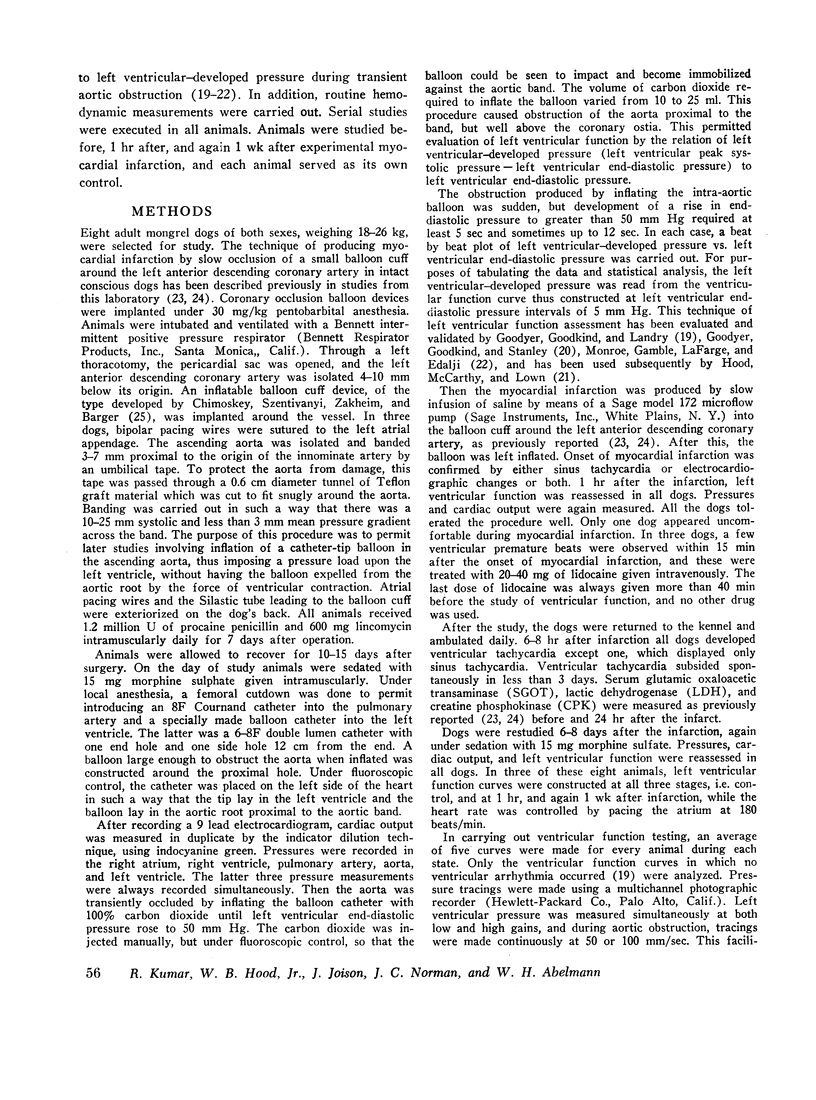

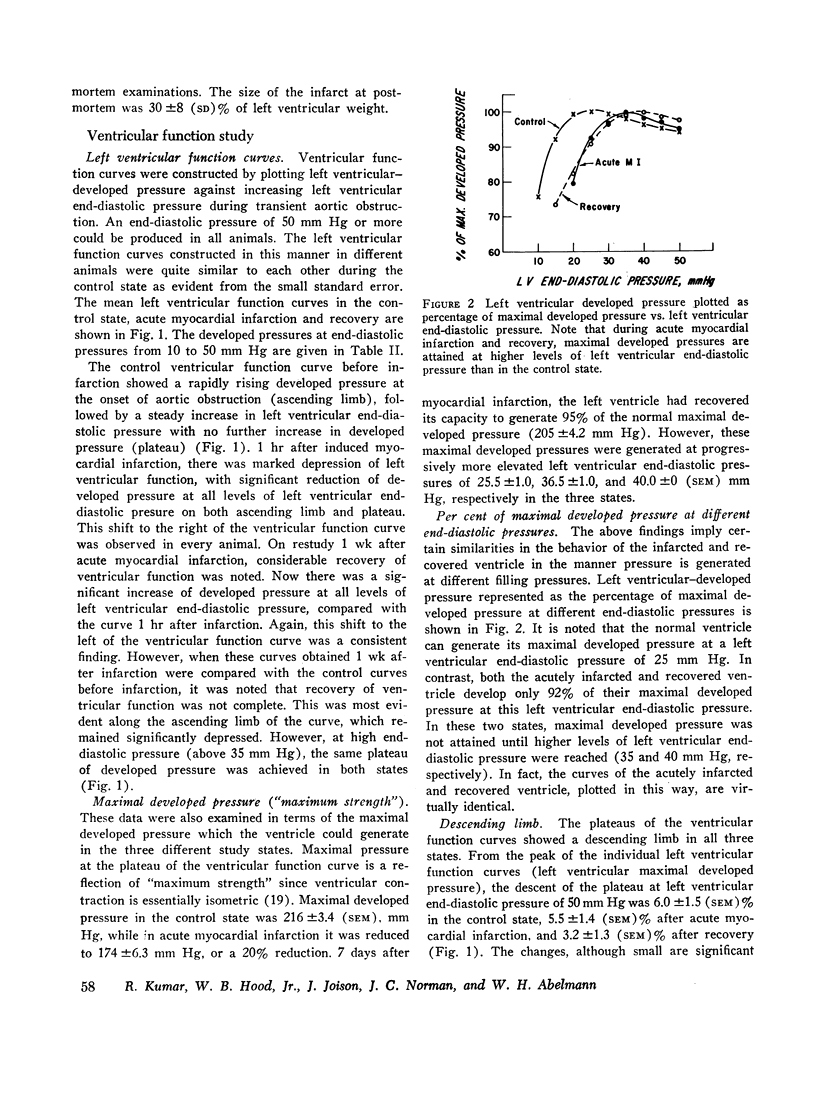
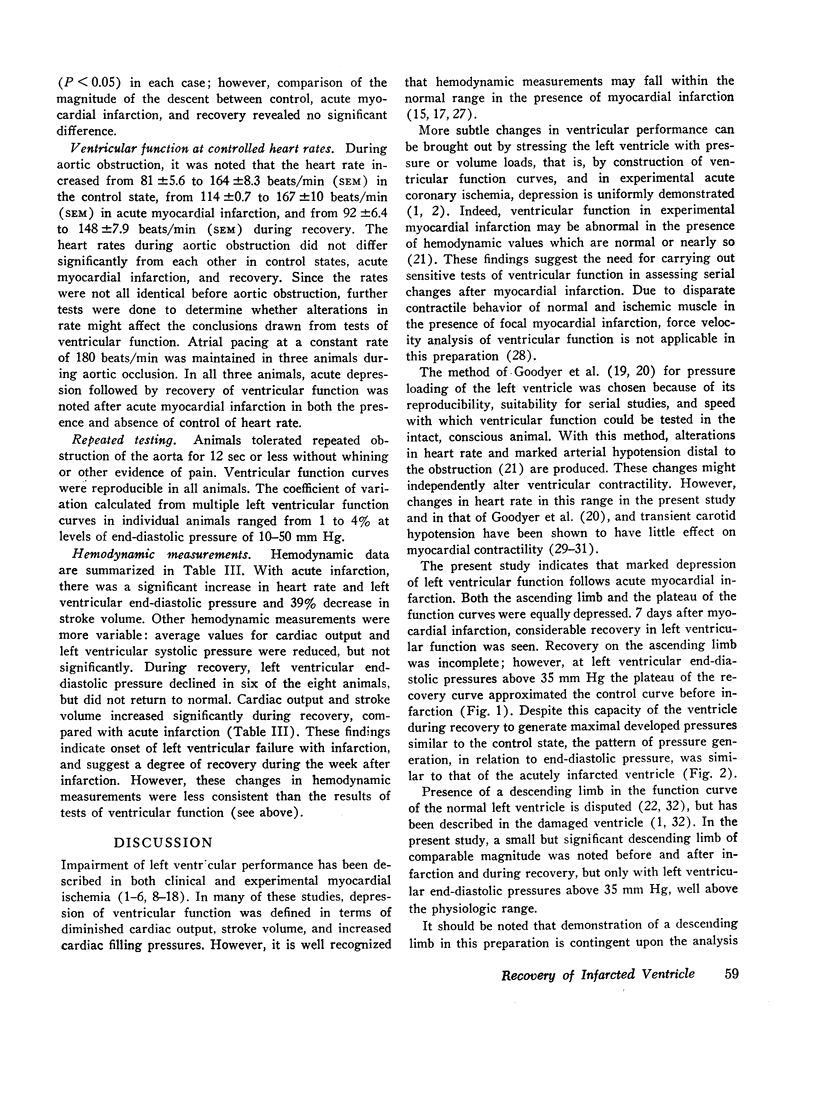
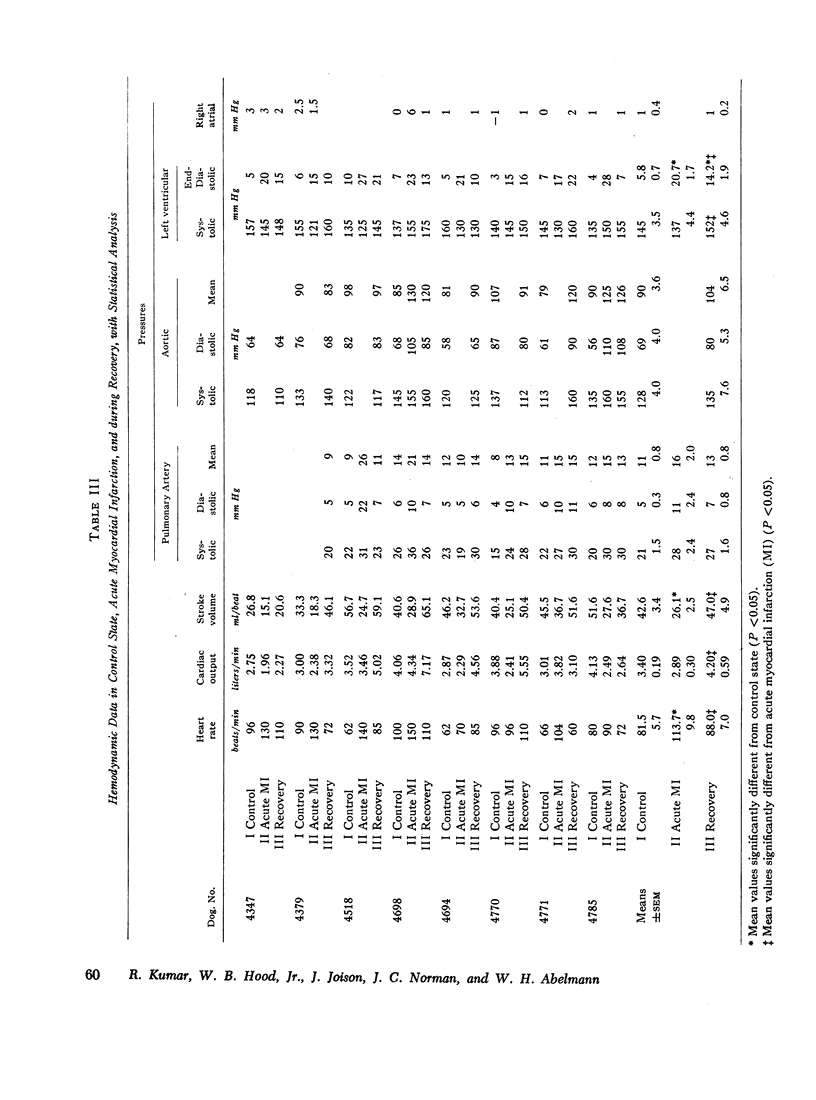

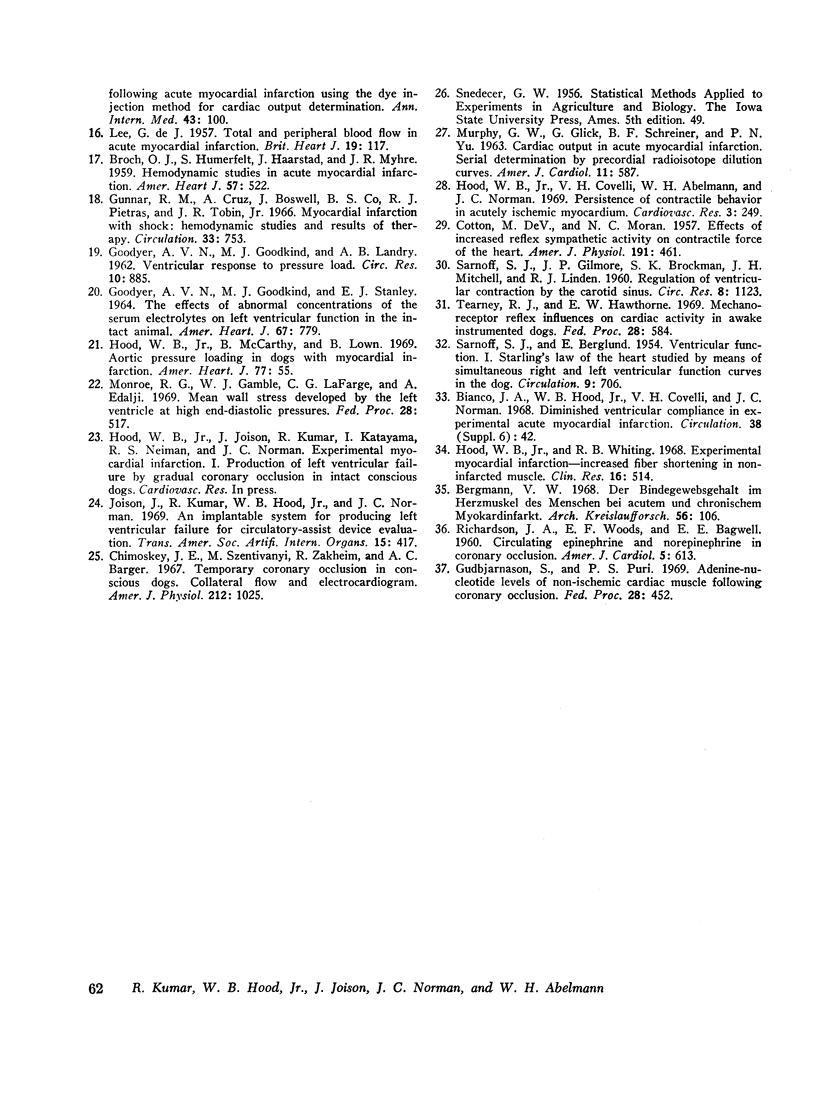
Selected References
These references are in PubMed. This may not be the complete list of references from this article.
- AGRESS C. M., GLASSNER H. F., BINDER M. J., FIELDS J. Hemodynamic measurements in experimental coronary shock. J Appl Physiol. 1957 May;10(3):469–475. doi: 10.1152/jappl.1957.10.3.469. [DOI] [PubMed] [Google Scholar]
- BROCH O. J., HUMERFELT S., HAARSTAD J., MYHRE J. R. Hemodynamic studies in acute myocardial infarction. Am Heart J. 1959 Apr;57(4):522–529. doi: 10.1016/0002-8703(59)90029-8. [DOI] [PubMed] [Google Scholar]
- Bergmann W. Der Bindegewebsgehalt im Herzmuskel des Menschen bei akutem und chronischem Myokardinfarkt. Arch Kreislaufforsch. 1968 Jun;56(1):106–126. [PubMed] [Google Scholar]
- CASE R. B., BERGLUND E., SARNOFF S. J. Ventricular function. II. Quantitative relationship between coronary flow and ventricular function with observations on unilateral failure. Circ Res. 1954 Jul;2(4):319–325. doi: 10.1161/01.res.2.4.319. [DOI] [PubMed] [Google Scholar]
- COTTEN M. D., MORAN N. C. Effects of increased reflex sympathetic activity on contractile force of the heart. Am J Physiol. 1957 Dec;191(3):461–468. doi: 10.1152/ajplegacy.1957.191.3.461. [DOI] [PubMed] [Google Scholar]
- Chimoskey J. E., Szentivanyi M., Zakheim R., Barger A. C. Temporary coronary occlusion in conscious dogs: collateral flow and electrocardiogram. Am J Physiol. 1967 May;212(5):1025–1032. doi: 10.1152/ajplegacy.1967.212.5.1025. [DOI] [PubMed] [Google Scholar]
- FREIS E. D., SCHNAPER H. W., JOHNSON R. L., SCHREINER G. E. Hemodynamic alterations in acute myocardial infarction. I. Cardiac output, mean arterial pressure, total peripheral resistance, central and total blood volumes, venous pressure and average circulation time. J Clin Invest. 1952 Feb;31(2):131–140. doi: 10.1172/JCI102584. [DOI] [PMC free article] [PubMed] [Google Scholar]
- GAMMILL J. F., APPLEGARTH J. J., REED C. E., FERNALD J. D., ANTENUCCI A. J. Hemodynamic changes following acute myocardial infarction using the dye injection method for cardiac output determination. Ann Intern Med. 1955 Jul;43(1):100–119. doi: 10.7326/0003-4819-43-1-100. [DOI] [PubMed] [Google Scholar]
- GILBERT R. P., GOLDBERG M., GRIFFIN J. Circulatory changes in acute myo cardial infarction. Circulation. 1954 Jun;9(6):847–852. doi: 10.1161/01.cir.9.6.847. [DOI] [PubMed] [Google Scholar]
- GOODYER A. V., GOODKIND M. J., LANDRY A. B. Ventricular response to a pressure load. Left ventricular function curves in intact animal. Circ Res. 1962 Jun;10:885–896. doi: 10.1161/01.res.10.6.885. [DOI] [PubMed] [Google Scholar]
- GOODYER A. V., GOODKIND M. J., STANLEY E. J. THE EFFECTS OF ABNORMAL CONCENTRATIONS OF THE SERUM ELECTROLYTES ON LEFT VENTRICULAR FUNCTION IN THE INTACT ANIMAL. Am Heart J. 1964 Jun;67:779–791. doi: 10.1016/0002-8703(64)90179-6. [DOI] [PubMed] [Google Scholar]
- Goldfarb D., Gott V. L. Cardiovascular alterations during declining and steady-state low cardiac output secondary to coronary insufficiency in thedog. J Thorac Cardiovasc Surg. 1968 Oct;56(4):578–589. [PubMed] [Google Scholar]
- Gunnar R. M., Cruz A., Boswell J., Co B. S., Pietras R. J., Tobin J. R., Jr Myocardial infarction with shock. Hemodynamic studies and results of therapy. Circulation. 1966 May;33(5):753–762. doi: 10.1161/01.cir.33.5.753. [DOI] [PubMed] [Google Scholar]
- Hood W. B., Jr, Covelli V. H., Abelmann W. H., Norman J. C. Persistence of contractile behaviour in acutely ischaemic myocardium. Cardiovasc Res. 1969 Jul;3(3):249–260. doi: 10.1093/cvr/3.3.249. [DOI] [PubMed] [Google Scholar]
- Hood W. B., Jr, McCarthy B., Lown B. Aortic pressure loading in dogs with myocardial infarction. Am Heart J. 1969 Jan;77(1):55–62. doi: 10.1016/0002-8703(69)90129-x. [DOI] [PubMed] [Google Scholar]
- Joison J., Kumar R., Hood W. B., Jr, Norman J. C. An implantable system for producing left ventricular failure for circulatory-assist device evaluation. Trans Am Soc Artif Intern Organs. 1969;15:417–423. [PubMed] [Google Scholar]
- LEE G. J. Total and peripheral blood flow in acute myocardial infarction. Br Heart J. 1957 Jan;19(1):117–128. doi: 10.1136/hrt.19.1.117. [DOI] [PMC free article] [PubMed] [Google Scholar]
- MURPHY G. W., GLICK G., SCHREINER B. F., Jr, YU P. N. Cardiac output in acute myocardial infarction. Serial determination by precordial radioisotope dilution curves. Am J Cardiol. 1963 May;11:587–593. doi: 10.1016/0002-9149(63)90077-8. [DOI] [PubMed] [Google Scholar]
- PRITCHARD W. H., HELLERSTEIN H. K. Cardiac catheterization following acute myocardial infarction. J Clin Invest. 1950 Jun;29(6):839–839. [PubMed] [Google Scholar]
- RENAIS J., SCEBAT L., LENEGRE J. ISCH'EMIE MYOCARDIQUE EXP'ERIMENTALE DU CHIEN. IV. CONS'EQUENCES H'EMODYNAMIQUES. Arch Mal Coeur Vaiss. 1964 May;57:602–617. [PubMed] [Google Scholar]
- SARNOFF S. J., BERGLUND E. Ventricular function. I. Starling's law of the heart studied by means of simultaneous right and left ventricular function curves in the dog. Circulation. 1954 May;9(5):706–718. doi: 10.1161/01.cir.9.5.706. [DOI] [PubMed] [Google Scholar]
- SARNOFF S. J., GILMORE J. P., BROCKMAN S. K., MITCHELL J. H., LINDEN R. J. Regulation of ventricular contraction by the carotid sinus. Its effect on atrial and ventricular dynamics. Circ Res. 1960 Sep;8:1123–1136. doi: 10.1161/01.res.8.5.1123. [DOI] [PubMed] [Google Scholar]
- SMITH W. W., WIKLER N. S., FOX A. C. Hemodynamic studies of patients with myocardial infarction. Circulation. 1954 Mar;9(3):352–362. doi: 10.1161/01.cir.9.3.352. [DOI] [PubMed] [Google Scholar]
- STONE H. L., BISHOP V. S., GUYTON A. C. Cardiac function after embolization of coronaries with microspheres. Am J Physiol. 1963 Jan;204:16–20. doi: 10.1152/ajplegacy.1963.204.1.16. [DOI] [PubMed] [Google Scholar]
- WEGRIA R., FRANK C. W., MISRAHY G. A., WANG H. H., MILLER R., CASE R. B. Immediate hemodynamic effects of acute coronary artery occlusion. Am J Physiol. 1954 Apr;177(1):123–127. doi: 10.1152/ajplegacy.1954.177.1.123. [DOI] [PubMed] [Google Scholar]


